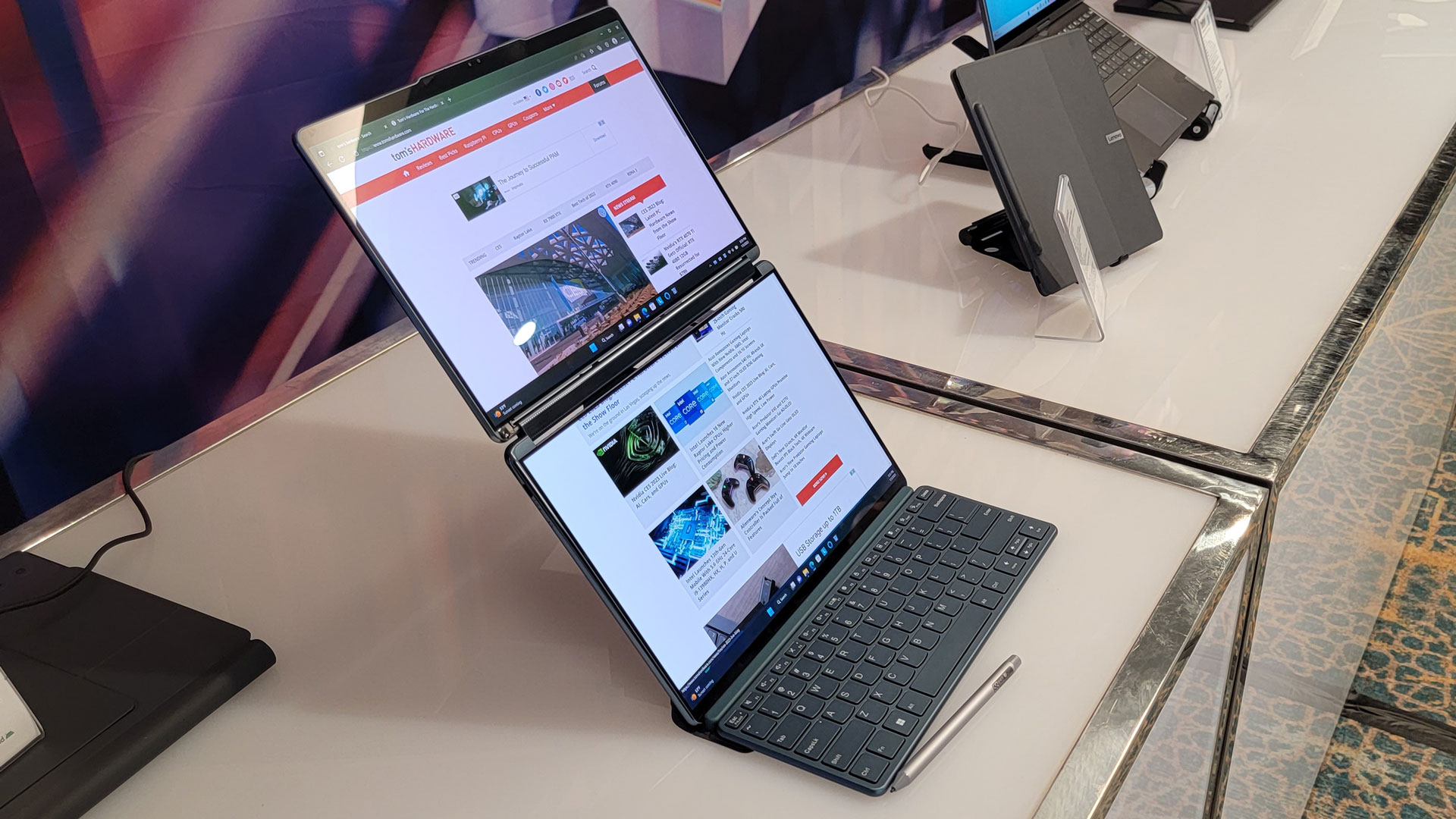Lenovo’s newest laptop has not one, but two full-size screens. At CES 2023, it announced the Yoga Book 9i, which it has billed as the “first full size dual screen OLED laptop.” It’s reminiscent of (but bigger than) the Surface Neo, a dual-screen foldable that Microsoft announced but never produced.
Each of the Yoga Book’s screens is a 13.3-inch, 2.8K screen with a 16:10 aspect ratio and Dolby Vision support, which Lenovo has dubbed “PureSight.” It’s powered by Intel’s 13th Gen Core i7-U15 processors, with up to 16GB of LPDDR5X RAM and either 512GB or 1TB of PCie SSD Gen 4 storage.
But rather than using a single folding screen, like Lenovo’s own ThinkPad X1 Fold, the Yoga Book 9i uses two panels, which fold together into a neat clamshell. This allows for plenty of standard convertible 2-in-1 functions, like tablet or tent mode. The screens can also be used one on top of the other, or side by side. The device is 11.78 x 8.03 x 0.64 inches and weighs 3.04 pounds. Like several of Lenovo’s other Yoga flagships, there’s a 360-degree rotating soundbar attached to the hinge.
Unlike the Neo, which was envisioned more like a tablet, the Lenovo has a bit of a laptop feel, due to the included folio stand that holds the screens up at an angle. (You could, of course, hold it like a regular laptop without a stand, with one screen on the bottom and one on the top.) The stand looks complicated, but we’ll have to spend extended hands-on time with it to see if that’s the case. It would be nice to see it built into the device, but I’m not sure it could be so svelte if that were the case.
There’s also a detachable Bluetooth keyboard, which can be used separately from the device or attached to it in order to mimic a clamshell laptop, as well as a stylus. Windows 11’s window management and snap tools should also help with the dual-screen layout.
Lenovo is highlighting the Yoga Book’s ability to be used in offices and classrooms, using software to notetaking or giving presentations while looking at one screen and showing the other. You can switch between using the two screens separately or combining them into one display with a five-finger tap. You can use the three Thunderbolt 4 ports for plugging in accessories or other devices.
The device comes in a very eye-catching “tidal teal,” and I’m a bit surprised not to see listings for a gray or silver version. That sure is one way to make a statement.
We’ve seen Lenovo’s Yoga Book lineup use two-screens before, but typically, one of them would be
an e-ink display
. We’ve been seeing full-size dual-screen laptops teased since at least 2018, when Asus showed off a concept called
Project Precog
.
The Yoga Book 9i is planned to launch in June, starting at $2,099.99.
Some More Traditional Options
Lenovo is also announcing some more conventional 2-in-1 designs in the Yoga 9i,Yoga 6 and Slim 7.
The 9i and and Yoga 6 are refreshes of previous models. The 9i is getting 13th Gen Intel Core i7 P series chips, along with up to 16GB of LPDDR5 RAM and up to 1TB of PCIe SSD Gen 4 storage. There will be 4K (3840 x 2400) and 2.8K (2880 x 1800) OLED display options. The Yoga 6 will use AMD’s Ryzen 7 7730U or Ryzen 5 7530U (these are Zen 3 chips), with up to 15GB LPDDR4x and up to 1TB of SSD storage. It will have a 13.3-inch 1920 x 1200 touch screen, and come in metal and fabric finishes. The Yoga 9i will start at $1,499.99 when it ships in April, while the Yoga 6 will begin at a cheaper $729.99 around the same time.
The Slim 7 is a newer device (known as the Slim 6i outside of the U.S.), with a 14-inch, 16:10 screen at either 2880 x 1800, 2240 x 1400, or 1920 x 1200, and will be powered by the latest 13th Gen Intel Core processors in an all-aluminum chassis. It will start at $729.99 in April.
